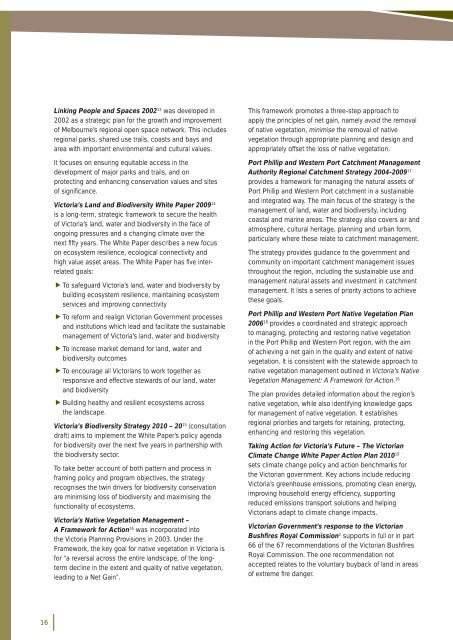Metropolitan Melbourne Investigation Discussion Paper - Victorian ...
Metropolitan Melbourne Investigation Discussion Paper - Victorian ...
Metropolitan Melbourne Investigation Discussion Paper - Victorian ...
You also want an ePaper? Increase the reach of your titles
YUMPU automatically turns print PDFs into web optimized ePapers that Google loves.
Linking People and Spaces 2002 13 was developed in<br />
2002 as a strategic plan for the growth and improvement<br />
of <strong>Melbourne</strong>’s regional open space network. This includes<br />
regional parks, shared use trails, coasts and bays and<br />
area with important environmental and cultural values.<br />
It focuses on ensuring equitable access in the<br />
development of major parks and trails, and on<br />
protecting and enhancing conservation values and sites<br />
of signifi cance.<br />
Victoria’s Land and Biodiversity White <strong>Paper</strong> 2009 14<br />
is a long-term, strategic framework to secure the health<br />
of Victoria’s land, water and biodiversity in the face of<br />
ongoing pressures and a changing climate over the<br />
next fi fty years. The White <strong>Paper</strong> describes a new focus<br />
on ecosystem resilience, ecological connectivity and<br />
high value asset areas. The White <strong>Paper</strong> has fi ve interrelated<br />
goals:<br />
G To safeguard Victoria’s land, water and biodiversity by<br />
building ecosystem resilience, maintaining ecosystem<br />
services and improving connectivity<br />
G To reform and realign <strong>Victorian</strong> Government processes<br />
and institutions which lead and facilitate the sustainable<br />
management of Victoria’s land, water and biodiversity<br />
G To increase market demand for land, water and<br />
biodiversity outcomes<br />
G To encourage all <strong>Victorian</strong>s to work together as<br />
responsive and effective stewards of our land, water<br />
and biodiversity<br />
G Building healthy and resilient ecosystems across<br />
the landscape.<br />
Victoria’s Biodiversity Strategy 2010 – 20 15 (consultation<br />
draft) aims to implement the White <strong>Paper</strong>’s policy agenda<br />
for biodiversity over the next fi ve years in partnership with<br />
the biodiversity sector.<br />
To take better account of both pattern and process in<br />
framing policy and program objectives, the strategy<br />
recognises the twin drivers for biodiversity conservation<br />
are minimising loss of biodiversity and maximising the<br />
functionality of ecosystems.<br />
Victoria’s Native Vegetation Management –<br />
A Framework for Action 16 was incorporated into<br />
the Victoria Planning Provisions in 2003. Under the<br />
Framework, the key goal for native vegetation in Victoria is<br />
for “a reversal across the entire landscape, of the longterm<br />
decline in the extent and quality of native vegetation,<br />
leading to a Net Gain”.<br />
This framework promotes a three-step approach to<br />
apply the principles of net gain, namely avoid the removal<br />
of native vegetation, minimise the removal of native<br />
vegetation through appropriate planning and design and<br />
appropriately offset the loss of native vegetation.<br />
Port Phillip and Western Port Catchment Management<br />
Authority Regional Catchment Strategy 2004-2009 17<br />
provides a framework for managing the natural assets of<br />
Port Phillip and Western Port catchment in a sustainable<br />
and integrated way. The main focus of the strategy is the<br />
management of land, water and biodiversity, including<br />
coastal and marine areas. The strategy also covers air and<br />
atmosphere, cultural heritage, planning and urban form,<br />
particularly where these relate to catchment management.<br />
The strategy provides guidance to the government and<br />
community on important catchment management issues<br />
throughout the region, including the sustainable use and<br />
management natural assets and investment in catchment<br />
management. It lists a series of priority actions to achieve<br />
these goals.<br />
Port Phillip and Western Port Native Vegetation Plan<br />
2006 18 provides a coordinated and strategic approach<br />
to managing, protecting and restoring native vegetation<br />
in the Port Phillip and Western Port region, with the aim<br />
of achieving a net gain in the quality and extent of native<br />
vegetation. It is consistent with the statewide approach to<br />
native vegetation management outlined in Victoria’s Native<br />
Vegetation Management: A Framework for Action. 16<br />
The plan provides detailed information about the region’s<br />
native vegetation, while also identifying knowledge gaps<br />
for management of native vegetation. It establishes<br />
regional priorities and targets for retaining, protecting,<br />
enhancing and restoring this vegetation.<br />
Taking Action for Victoria’s Future – The <strong>Victorian</strong><br />
Climate Change White <strong>Paper</strong> Action Plan 2010 19<br />
sets climate change policy and action benchmarks for<br />
the <strong>Victorian</strong> government. Key actions include reducing<br />
Victoria’s greenhouse emissions, promoting clean energy,<br />
improving household energy effi ciency, supporting<br />
reduced emissions transport solutions and helping<br />
<strong>Victorian</strong>s adapt to climate change impacts.<br />
<strong>Victorian</strong> Government’s response to the <strong>Victorian</strong><br />
Bushfires Royal Commission 2 supports in full or in part<br />
66 of the 67 recommendations of the <strong>Victorian</strong> Bushfi res<br />
Royal Commission. The one recommendation not<br />
accepted relates to the voluntary buyback of land in areas<br />
of extreme fi re danger.<br />
16
















